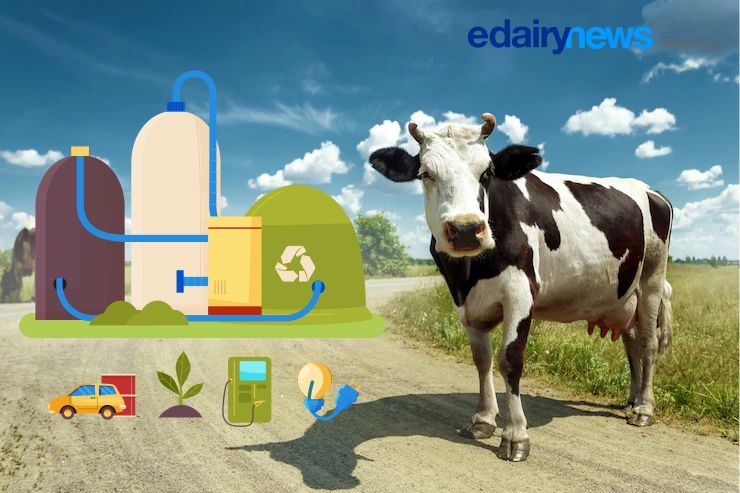Restricting livestock farming causes us a lot of damage and no environmental solution. It’s not that way. We repeat almost like a mantra that the methane emitted by cattle is not what warms the planet, but is part of a biogenic cycle, which is recycled in photosynthesis. The same cows that provide us with milk, a food so fundamental to our health, our cognitive development and our food culture, are the same cows capable of freeing us from the fossil fuel dependence that is responsible for accelerating climate change.
With an energy crisis related to oil coming from Russia, the first biogas plants started to appear in Germany in 2002, setting a trend in energy generation through effluent treatment.
The study of anaerobic digestion arose from sanitary engineering, as one of the many processes that exist for the treatment of effluents, especially sewage. When it became clear that this treatment generated a significant volume of energy, and especially in recent years when emphasis has been placed on the need to reduce fossil fuel sources, the use of this technology to generate bioenergy began to proliferate.
What is the technological scope of biogas? With a calorific value of 5500 kcal per m3, methane can replace fossil fuel. German technology has spread to the Nordic countries, reached Brazil, and is also present in Canada and the United States.
When managing a farm with an intensive livestock raising process, the effluents are no longer waste but a by-product: the raw material for bio natural gas, or biomethane. The production of biogas has a triple positive impact, at the same time that it contributes to environmental health, in that healthy environment it allows people to use a technology that also gives them an economic profitability in the generation of energy.
Biogas is a mixture of gases, product of the process of anaerobic fermentation of organic waste, which in this case are resources, of which 60% is fuel. By decomposing these resources, under precise conditions, such as the absence of oxygen and the action of certain methanogenic bacteria that act in their fermentation, we can produce biogas. This biogas contains 60% methane, 30% carbon dioxide and traces of other gases such as hydrogen sulfide, nitrogen, water vapor and traces of oxygen. Methane gas is the upgrading of biogas.
Methane is one of the main greenhouse gases, so it is important to reduce its emissions, or take advantage of them. In this circular scheme, by generating methane gas from a renewable, biological or natural source and burning it, carbon, the main GHG, is balanced. This would reduce 20 times the effect that this gas would generate in the atmosphere, making it a great tool for mitigating the effects of climate change, while replacing fossil sources of energy generation such as natural gas.
Anaerobic digestion technology can be used for the sanitation of agro-industrial establishments such as dairy farms, using the energy produced to generate electricity, heat or cold, allowing them to self-supply their internal consumption and generating substantial savings. The pollution complications associated with dairy effluents are finally an economic opportunity.
It all depends on how the effluent is handled, how it is collected and its quality, but for every kg of fresh manure from a dairy cow, a yield of up to 40 liters of biogas is obtained. In a pastoral system, between the holding pen and the milking parlor, up to 3 kg of fresh manure can be obtained from each animal.
There are many positive experiences on the use of biodigesters in large-scale dairy farms, and less experience on smaller scales. The market offers a great variety of biodigesters in terms of design, materials, price, capacity, energy production efficiencies, ease of maintenance, etc., it is necessary to find the one that best suits each approach in technical and economic terms.
The multiplicity of benefits differentiates biodigesters from other renewable energy technologies, which only produce energy, and from other organic waste treatment processes, which only produce fertilizer for nutrient recycling.
Current waste management represents a weakness for the milk production system. Very few producers carry out a correct management and handling of effluents, many deposit them in unsealed lagoons and, in general, there is a lack of knowledge of the quantity and quality of the effluent generated.
Changes in favor of environmental care are a trend because as science and technology advance, we are learning to improve in all aspects, without neglecting productive performance. And although the politician may be uncomfortable when I speak of “Taliban” of climate change, it is important to highlight and call attention to the fact that they are not going to “save” us or the planet, neither by decimating livestock, nor by suffocating the producer with more taxes that finally do nothing more than take away the possibilities of investing in new technologies.
There is no other sustainability than that of the countryside producing our food. And although he works tirelessly to protect the nature he uses, because it is his livelihood and also his home, he is accused by ignorant activism, to which blind politics responds without asking science or observing reality.
Consuming dairy products is good, and producing them is a noble task full of love, work, care for nature and attention to animal welfare, capable of providing not only food, but also energy. Let’s support dairy farming from all sectors of society.
Have you had your glass of milk today?
Valeria Guzmán Hamann
EDAIRYNEWS










